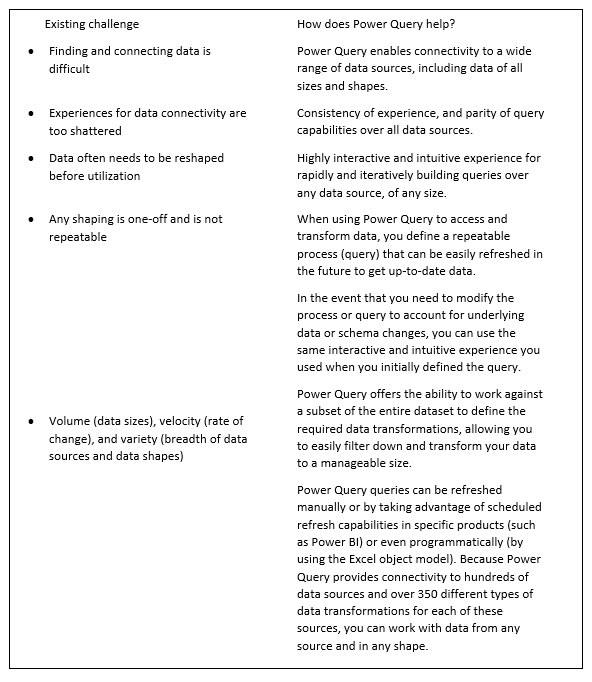How Power Query is used for Data Transformation
Power Query is used for data transformation and data preparation. Power Query consists of a graphical user interface for getting data from different sources and a Power Query Editor for filtering the data. Since the engine is available in many products and services, the destination where the data will be stored totally depends on where the Power Query was used. Using the Power Query editor, you can perform the extract, transform, and load (ETL) processing of data.
How Power Query helps with Data Acquisition:
Business users consume up to 80 percent of their time on
data preparation, which also delays the work of analysis and decision-making.
Transformations:
The transformation engine in Power
Query includes many predefined transformation functions that can be used
through the graphical interface of the Power Query Editor. These
transformations are often as simple as removing a column or filtering rows, or
as common as using the primary row as a table header. There are such advanced
transformation options like merge, append, group by, pivot, and unpivot.
All these transformations are made possible with the help of
choosing the transformation option in the menu, and then applying the options
required for the transformation. The following illustration shows a couple of
the transformations available in Power Query Editor:
Dataflows:
Power
Query is used in many products, for instance in Power BI
and Excel. However, using Power Query within a product has certain
limitations with its usage to only that specific product. Using dataflows, you
can get the data and transform it in the same way, but instead of sending the
output to Power BI
or Excel, you can store the output in other storage options like Dataverse
or Azure Data Lake Storage. This way, you'll use the output of dataflows in
other products and services.
Power Query M Language:
In any data transformation framework, there are some
transformations that can't be done in the best way by using the graphical
editor. Some of these transformations might require special configurations and
settings that the graphical interface does not support currently. The Power
Query engine uses a scripting language behind the scenes for all the Power
Query transformations: the Power
Query M language, also known as M.
The M language is that the data transformation language of Power
Query. Anything that happens in the query is ultimately written in M. If
you would like to try to advanced transformations using the facility Query
engine, you'll use the Advanced Editor to access the script of the query and
modify it as you would like. If you discover that the interface functions and
transformations won't perform the precise changes you would like, use the
Advanced Editor and therefore the M language
to fine-tune your functions and transformations.
Power Query experiences:
The Power
Query user experience is provided through the facility Query Editor
interface . The goal of this interface is to assist you implement the
transformations you would like just by interacting with a user-friendly set of
ribbons, menus, buttons, and other interactive components.
The Power
Query Editor is that the first data preparation experience, where you'll
attach with an honest range of data sources and apply many various data
transformations by previewing data and selecting transformations from the
interface. These data transformation capabilities are common across all the
info sources, regardless of the underlying data source limitations.
When you create a replacement transformation step by
interacting with the components of the Power Query interface, Power
Query automatically creates the M code required to undertake to the
transformation so you do not get to write any code.
Data
analytics is a process of inspecting, cleansing, transforming, and modelling
of the data with the aim of discovering useful information, informing
conclusions and supporting decision-making. Data
analytics has multiple features and approaches, encompassing diverse
techniques under a variety of names, and is used in different business,
science, and social science domains. In today's business world, Data Analytics
plays a vital role in making decisions more scientific and helping businesses
operate more effectively. Nowadays, the Data
analytics masters programming course is the latest and trending language in
the corporate world.
Brillica Services
provides the best knowledge about Data Analytics
Masters training program in Dehradun. Data
Analytics certification is the most popular and powerful programming
language used mostly in all Data
analytics courses in Dehradun Uttarakhand, Data Analytics certification and
operations.
Follow for more : https://www.brillicaservices.com/#




Comments
Post a Comment